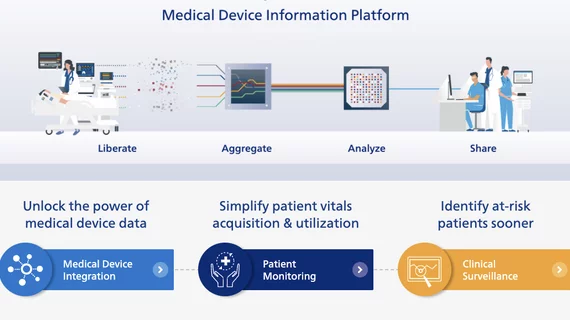New levels of patient monitoring interoperability between various, disparate vendor devices and applications can now be integrated into a single user interface. Philips Healthcare this week said its Capsule Medical Device Information Platform (MDIP) now interfaces smoothly with its Patient Information Center iX (PIC iX). The company said this enables hospitals with a first-of-its-kind, comprehensive patient overview with data from various vendor devices in one location.
Interoperability between MDIP and PIC iX gives clinicians a new clinical perspective that enables the capture of streaming data flowing freely from a variety of medical device manufacturers on an open, scalable, secure platform. By disseminating this information through the Patient Information Center, clinicians have a single source, comprehensive overview of a patient’s condition that helps empower caregivers to make treatment recommendations confidently from anywhere throughout the hospital’s digital environment.
“Every day, clinicians make countless care decisions based on information from divided medical devices and systems. It’s time we start caring for the carers by making data more accessible,” said Christoph Pedain, general manager, Philips hospital patient monitoring, said in a statement. “By ever-improving availability and accessibility of patient information, clinicians and patients benefit through enhanced workflows, insights, improved care delivery and safety measures that may lead to better health outcomes and the better use of staff and infrastructure.”
Breaking down patient data barriers in patient monitoring
Historically, data from medical device vendors has been siloed, leaving clinicians with the laborious task of referencing multiple data sources to gain a complete clinical view of the patient. The inefficiencies caused by this disjointed process can impact a clinician’s ability to deliver timely diagnoses and treatments to patients. Philips said it is addressing technical obstacles associated with interoperability, such as device-specific connectivity protocols and security challenges across the organization, to help caregivers view, document, report, and analyze data before making care-related decisions.
Pulling data from a variety of different non-Philips devices, such as ventilators, infusion pumps and third-party vital signs monitors, Philips presents and distributes the information in a single, standardized interface. Clinicians are then presented with a comprehensive picture of a patient's health based on available medical device data.
Philips said access to this level of detailed information may minimize the time a clinician spends prioritizing data from multiple sources. With the goal of creating efficiencies associated with determining diagnoses and treatment decisions, this new interoperability may allow caregivers to spend more time providing direct patient care.
Data can be captured from almost any device or patient monitor vendor using the Philips interfaces. Harmonized data is then available to caregivers across the hospital. A streamlined, standardized view of the patient can be accessed through the central station, web, or mobile application, so clinicians can act more quickly regardless of their location in the hospital. Meaningful insights and status updates allow clinicians to automate administrative tasks or close information gaps, helping them save time and get back to treating patients, Philips said.
The company said this interoperability is part of Philips’ efforts to create a large open patient monitoring ecosystem that includes third-party applications and algorithms.

